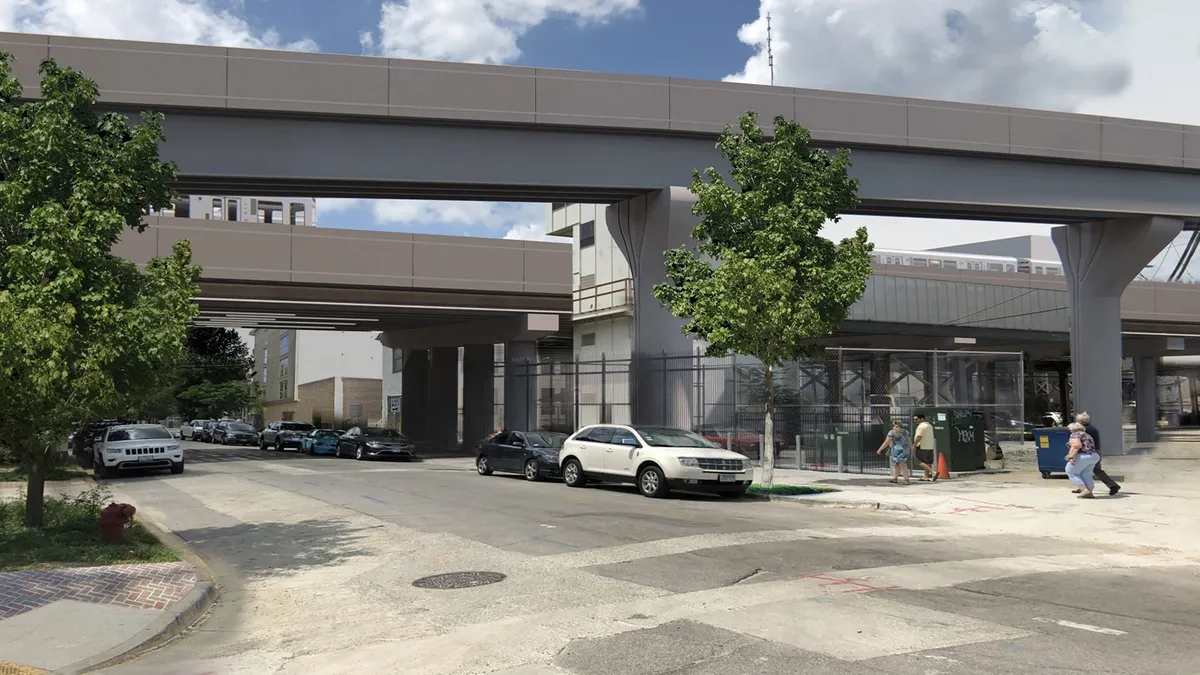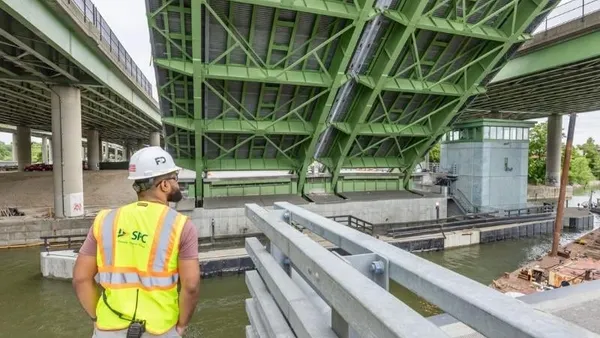Dive Brief:
- A major portion of an overhaul of the Red and Purple lines on the Chicago "L" train system is complete with the opening of a new bypass structure on Nov. 19, the Chicago Transit Authority announced. The new $1.3B bridge and tracks are designed to break up a nearly century-old bottleneck issue.
- General contractor Walsh Construction and engineering and construction firm Fluor Construction joined forces as primary contractors for the project. Stantec is lead designer, and EXP, International Bridge Technologies and TranSmart/EJM Engineering also assisted with the work.
- The bypass is part of the larger Red and Purple Modernization (RPM) project meant to fix or replace tracks and stations along an almost 10-mile stretch in order to accommodate growing ridership. The new rail bridge, which began construction in 2019, is about 0.3 miles long and marks the first new section of track added to CTA since the Orange Line opened 28 years ago.
Dive Insight:
Instead of three train lines trying to navigate the same section of tracks, the new bypass allows Brown Line trains to travel above the Red and Purple lines on an elevated track. As a result, the new bridge bypass breaks up a bottleneck in this area, allows up to eight more Red Line trains per hour to run during rush hour and ramps up Red and Purple Line speeds by 60%, according to the CTA. The bypass is expected to save about 500,000 hours of travel time for riders each year, the agency said.
To create the bypass and new track system — while minimizing disruption in the highly populated area located a few blocks from Wrigley Field — the construction team built a gantry to straddle the tracks and lift up components. The 285-foot structure was designed specifically for this job, said Kevin Buch, project manager for the bridge structure for Walsh-Fluor, during a September public meeting about the project.
The project used about 1,555 precast concrete segments to support the Red and Purple Line tracks, according to Buch, which were prefabricated in Morris, Illinois, cutting down on a lot of on-site work. Each segment is 27½ feet wide, nine feet tall and 8 to 11 feet long, and is reinforced with steel cables so that it can hang on its own.
Buch said that the team was able to minimize construction-related disturbance to the streets and surrounding community by bringing the prefabricated segments in from an offsite location and building the bridge in the air. The builders also found a way to use fewer columns to support the bypass without compromising its structural strength, according to a Fluor press release.
“Designing and building complex infrastructure projects in populous areas with limited impact to businesses, residents and commuters is a trademark of Fluor’s infrastructure business,” said Thomas Nilsson, president of Fluor’s infrastructure business, in the press release. “When complete, this project will improve the quality, safety and reliability with an upgraded transit experience for CTA riders.”
Building for future growth
Chicago’s population grew about 2% from 2010 to 2020, increasing from 2.6 million people to 2.7 million, according to Census data. Ridership on its train system has grown, too. In the past five years, the L saw a nearly 40% increase in passengers during morning and evening rush hour, according to the CTA.
In order to adjust to current and future ridership growth, the CTA embarked on the largest capital investment project in its history in 2019, with the goal of revamping service on the Red, Purple and Brown lines. Costs for Phase One will tap out at about $2.1 billion, according to the CTA, and the remaining projects are expected to be complete sometime in 2025.
The last time renovations were made on this portion of track was in 1924, according to the CTA, and much of the track and stations have aged past their usefulness. The RPM project will revitalize the Red and Purple lines from Belmont Station to Linden Station. The two other parts of Phase One are:
- Replacing the track signal system between Belmont and Howards stations.
- The Lawrence to Bryn Mawr Modernization Project, which would restore the Argyle, Berwyn, Bryn Mawr and Lawrence stations, including adding elevators and updating the stations to service people with disabilities.













